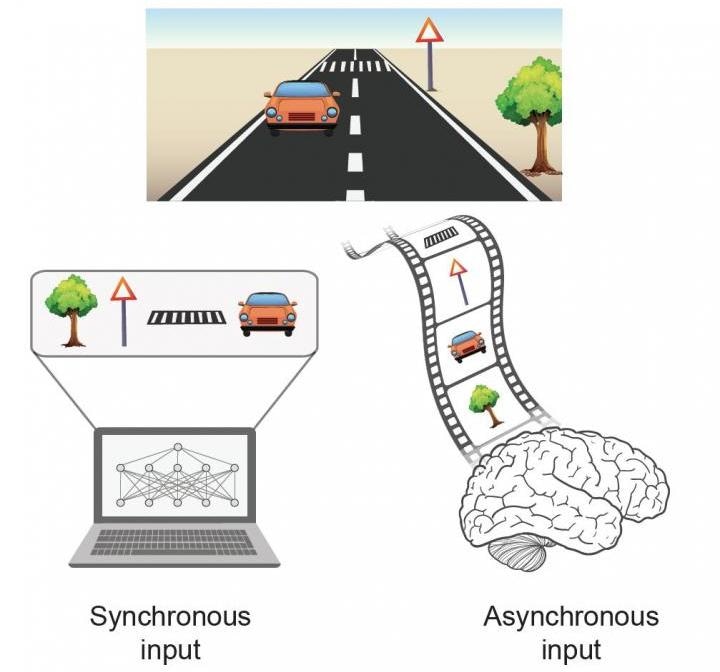Aug 12 2019
Machine learning came into existence about 70 years ago and is based on evidence of the dynamics of learning in man’s brain. Using the speed of contemporary computers and large data sets, deep learning algorithms have of late yielded results comparable to those of human specialists in numerous applicable fields, but with varied characteristics that are far from existing knowledge of learning in neuroscience.
 Processing an event with multiple objects. A synchronous input where all objects are presented simultaneously to a computer (left), versus an asynchronous input where objects are presented with temporal order to the brain (right). (Image credit: Prof. Ido Kanter)
Processing an event with multiple objects. A synchronous input where all objects are presented simultaneously to a computer (left), versus an asynchronous input where objects are presented with temporal order to the brain (right). (Image credit: Prof. Ido Kanter)
Using innovative experiments on neuronal cultures and large scale simulations, a team of researchers at Bar-Ilan University in Israel have shown a new kind of ultrafast artificial intelligence algorithms—based on the extremely slow brain dynamics—which outdo learning rates accomplished thus far by advanced learning algorithms.
In an article published recently in the journal Scientific Reports, the scientists reconstruct the bridge between neuroscience and progressive artificial intelligence algorithms that has been left virtually unusable for nearly seven decades.
"The current scientific and technological viewpoint is that neurobiology and machine learning are two distinct disciplines that advanced independently," said the study's lead author, Prof. Ido Kanter, of Bar-Ilan University's Department of Physics and Gonda (Goldschmied) Multidisciplinary Brain Research Center. "The absence of expectedly reciprocal influence is puzzling."
The number of neurons in a brain is less than the number of bits in a typical disc size of modern personal computers, and the computational speed of the brain is like the second hand on a clock, even slower than the first computer invented over 70 years ago. In addition, the brain's learning rules are very complicated and remote from the principles of learning steps in current artificial intelligence algorithms.
Ido Kanter, Study's Lead Author and Professor, Department of Physics and Gonda Multidisciplinary Brain Research Center, Bar-Ilan University
Ido Kanter’s study team includes Herut Uzan, Shira Sardi, Amir Goldental, and Roni Vardi.
Brain dynamics do not adhere to a distinct clock synchronized for all nerve cells, since the biological scheme has to deal with asynchronous inputs, as physical reality progresses.
When looking ahead one immediately observes a frame with multiple objects. For instance, while driving one observes cars, pedestrian crossings, and road signs, and can easily identify their temporal ordering and relative positions. Biological hardware (learning rules) is designed to deal with asynchronous inputs and refine their relative information.
Ido Kanter, Study's Lead Author and Professor, Department of Physics and Gonda Multidisciplinary Brain Research Center, Bar-Ilan University
On the other hand, traditional artificial intelligence algorithms are based on synchronous inputs, and hence the relative timing of various inputs constituting the same frame is usually overlooked.
The new research shows that ultrafast learning rates are astonishingly identical for small and large networks. Hence, say the scientists, “the disadvantage of the complicated brain’s learning scheme is actually an advantage."
Another crucial finding is that learning can take place without learning phases through self-adaptation according to asynchronous inputs. This kind of learning-without-learning takes place in the dendrites, more than a few terminals of each neuron, as was recently experimentally witnessed. Furthermore, network dynamics under dendritic learning are ruled by weak weights which were earlier deemed irrelevant.
The notion of efficient deep learning algorithms founded on the very slow brain's dynamics offers a chance to execute a new category of advanced artificial intelligence based on fast computers. It necessitates the re-initiation of the bridge from neurobiology to artificial intelligence and, as the research team concludes, "Insights of fundamental principles of our brain have to be once again at the center of future artificial intelligence."